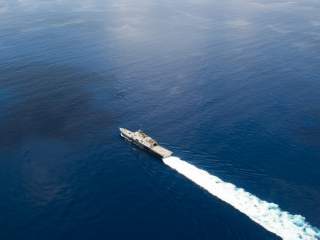How China's Worldviews Are Manifested in the South China Sea
China believes that it is on course to resume the central role it previously played in global affairs, and that the world should recognize this.
With the ongoing controversy over China's activities in the South China Sea, it is timely to explore how Chinese worldviews play out in practice. In particular, it is worth considering how they underpin Chinese foreign-policy behavior now, and may do so in the future; and how our own behavior may ultimately be counter-productive if we continue to ignore how the Chinese see the world.
The key worldviews in Chinese foreign policy are: the century of humiliation; the view of cultural characteristics as being inherent and unchanging; the idea of history as destiny; and notions of filial piety and familial obligation as they apply both inside China and to China’s neighbors.
Overall, these four worldviews add up to a China that believes it is on course to resume the central role it previously played in regional and global affairs, and that the outside world should recognize this. It feels it has been held back from this central role by the United States and some U.S. allies, and that these powers will continue to restrict China’s development where they can.
China’s recent actions in the South China Sea reflect several of these narratives, especially the narrative of history as destiny. According to this view, Chinese actions in the South China Sea reflect its gradual resumption of its rightful and respected place in the region.
China’s attitude towards the other claimants in the South China Sea reflects the narrative of filial piety and familial obligation. In this view, China’s role is that of a father figure and benevolent overseer of a peaceful region, in which its neighbors willingly and without coercion pay tribute and homage. By the same token, if China’s neighbors do not willingly pay tribute and homage then this is seen to justify taking stronger measures to ensure that this familial order is respected.
The narratives of the century of humiliation and the unchanging nature of cultural characteristics also inform how China sees the role that the United States is playing in the South China Sea. China interprets U.S. actions like its recent freedom of navigation patrol not as some limited exercise to uphold international maritime norms but as part of a long-standing effort to maintain its hegemony and keep China from resuming its rightful place in the world.
China’s recent actions in the East China Sea also reflect the four narratives noted above. China and Japan have had a long-term dispute over the Diaoyu/Senkaku islands which flared up again in 2012. In November 2013, China announced the creation of a new air defense identification zone (ADIZ) around the islands.
In this situation, the narratives of cultural characteristics as unchanging and the century of humiliation are particularly resonant. The focus is very much on Japan and the danger that it is seen to represent to China. This draws on the strong historical memory in China of Japanese expansionism in World War II, a memory that the Chinese authorities have done much recently to revive. Japan is portrayed as naturally imperialistic, expansionist, and untrustworthy.
The four worldviews are not just relevant to understanding Chinese behavior when it comes to security issues. Both the Asia Infrastructure Investment Bank (AIIB) and One Belt One Road initiatives (OBOR has a land-based Silk Road Economic Belt and ocean-going Maritime Silk Road, and aims to increase connectivity and cooperation among countries, principally in Eurasia) reflect the century of humiliation narrative and the idea of history as destiny. Both are portrayed within China as evidence that China is finally overcoming its period of weakness and vulnerability. As one Chinese academic said to me, these initiatives represent "a great shift from the idea of just taking care of ourselves." Rather, they are seen as a way for China to resume its rightful position as a wealthy, strong, and responsible power, at the center of a web of regional economic interdependence.
A call to understand these worldviews is not an argument for appeasement. In some cases policymakers will need to respond firmly to Chinese actions, even if this may have longer-term costs. In the East China Sea, the strong reaction of the United States and some of its allies to China’s ADIZ may well have reinforced narratives of persecution and humiliation.
However, understanding Chinese worldviews can help policymakers to develop responses that do not reinforce the negative aspects of these narratives in ways that are ultimately counterproductive. For example, in China, Washington’s tough response to the AIIB and its ambivalent attitude to OBOR will have reinforced the idea that despite its calls for China to be a responsible stakeholder, no matter what China does on the world stage, the United States will always try to curb China’s emergence as a more central actor in the international system.
Ultimately, choices about how the United States and its allies respond to China need to be taken on a case-by-case basis. In some cases U.S. and other Western policymakers may see no option but to take action that reinforces the more negative aspects of the Chinese narratives outlined above. In other cases, however, an understanding of these Chinese worldviews can help policymakers to avoid actions that are needlessly counterproductive.
Merriden Varrall's recent Lowy Institute Analysis: China's WorldViews and China's Foreign Policy can be downloaded here. This article first appeared in the Interpreter.
Image: Flickr/Naval Surface Warriors

